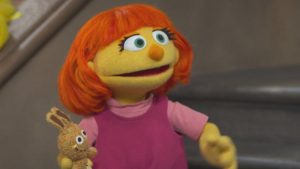Interview on the New Character with Autism on Sesame Street
Posted on April 13, 2017 at 12:00 pm
Julia, “Sesame Street’s” first character with autism, helps children and their families understand people on the spectrum. Jennifer Thorn, Ph.D., Associate Professor in the English Department of Saint Anselm College answered my questions about Julia and what she can teach us.
The autism spectrum includes a wide range of behaviors and capabilities. Is there a definition that describes everyone described as autistic?
The 1990 Individuals with Disabilities Education Improvement Act (IDEA-1990) defines autism as a category of developmental disability that significantly affects verbal and nonverbal communication and social interaction. IDEA-1990 recognizes that autism typically, but not always, becomes evident in children before the age of 3.
By classifying autism as a developmental disability, IDEA-1900 makes clear that it is not a condition arising from emotional disturbance.
Behaviors associated with autism, but not strictly definitional of it, include
• resistance to environmental change;
• discomfort due to heightened sensitivity to sensory stimuli; and
• engagement in repetitive actions.

Why is it important for children and their families to see an autistic character on television?
Current research indicates that half of American children live in homes where the television is on half of the time that family members are home, whether or not anyone is watching it. Three-fourths of American children now have access to mobile devices; one-fifth of these children use mobile devices daily. Children are awash in media, which carries messages, directly and by implication that children are more likely than adults to absorb, because they lack adults’ cognitive abilities.
TV shows offer visions of normalcy. Sesame Street has long recognized that the absence of certain kinds of people in programming conveys powerful messages about what lives are, and aren’t, valuable. Television models values and behaviors that children absorb. The absence of characters with autism suggests that their lives are less worthwhile than the lives of neurotypical people.
I say “characters with autism” rather than “autistic characters” because no one can be reduced to any one quality he or she might possess.
Why have a puppet with autism rather than bringing on a real child with autism as they do with other disabilities?
Sesame Street is to be commended (as it has frequently been, by numerous awards) for its inclusion of content relating to disabilities both to teach content and to model a “normalcy” in which people with disabilities are included.
For example, the violinist Itzak Perlman, who was born with polio, was featured in a 1981 segment in which a little girl ran up a set of steps that he then climbed with his crutches—teaching children about the obstacles that everyday life poses for so many. That segment offered content. In another segment, “Katie and the Baby,” a soon-to-be-big sister anticipated the arrival of a new sibling; the focus was on this ordinary, everyday experience. She had Down Syndrome, but the point was that she was an excited little girl facing an exciting new experience.
So both approaches are valuable—teaching, and taking for grant the presence of a person with a disability. The fact that Julia is a puppet (and such a very appealing one) also puts children at ease and gives them permission to have fun and laugh as they would watching any other character.
What can children learn from Julia about reaching out to people with autism?
Children can learn—and perhaps the older siblings and adults who might watch with them—that people with autism are people, too. First and foremost, including Julia in the gang, matter-of-factly playing and learning with friends and neighbors, shows that people with autism live lives as rich and individual and valuable as any other person’s.
What does it mean to be “culturally and linguistically diverse?”
This phrase means – being mindful of the complexity of “normal” and the ways that “normal” might be seen or experienced differently by different kinds of people. It involves recognizing that programming that shows children only one kind of person implicitly suggests that that kind of person is more normal, more valuable, than other people.
What are Julia’s special concerns and issues? Can she discuss her autism and guide others on how best to communicate with her?
I can’t speak for the writers (I can only trust and applaud them); my sense is that Sesame Street wants Julia to be “not a big deal”—one child with other children, having good days and bad days, problems one minute and joy the next. That integration is the real, and very powerful, value of the addition of Julia to the cast.
What will children with autism think about Julia?
Here I think of the words of Emily Perl Kingsley, the mother of a child with Down syndrome who began appearing on Sesame Street in 1977. In that era, it was widely assumed that children with Down syndrome could not be taught. She has written, of the power of Jason’s inclusion on the show: “Children with disabilities are pleased and proud to see other children like themselves represented on television as fully participating members of the community.”
